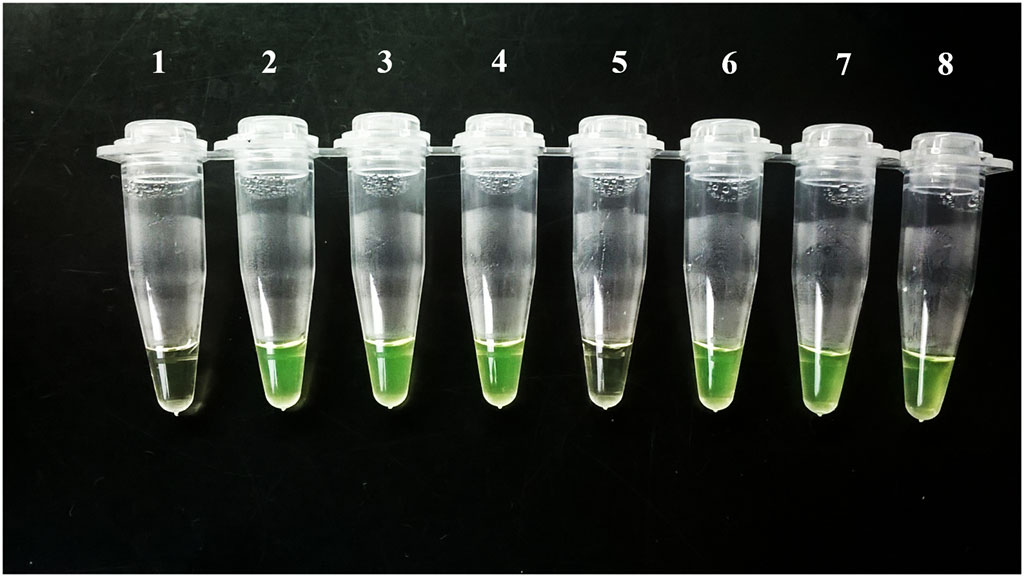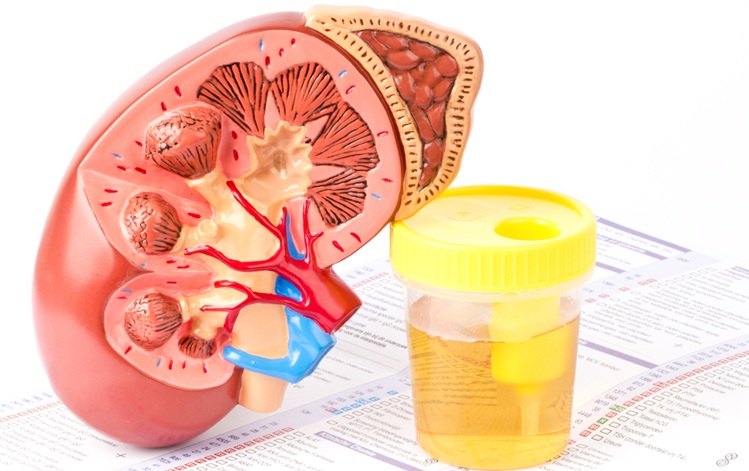Loop-Mediated Isothermal Amplification Kit Detects Chagas Disease
|
By LabMedica International staff writers Posted on 07 Sep 2020 |

Image: Visualization of Loopamp Trypanosoma cruzi results by the naked eye, Tubes 1 (Negative control) and 5 were negative, but #5 was positive on qPCR with a very low DNA load (Photo courtesy of Laboratorio de Biología Molecular de la Enfermedad de Chagas).
Chagas disease (CD), also known as American trypanosomiasis, is a neglected tropical disease caused by the protozoan parasite Trypanosoma cruzi that affects about six to seven million people worldwide, mainly in endemic areas of 21 Latin American countries.
The disease evolves from an acute phase when the infection is acquired, which is frequently asymptomatic, to a chronic phase that may develop, in up to 30% of cases, cardiac disease, and in 10% of cases digestive mega-syndromes, neurological and/or mixed complications.
Molecular Biologists at the Research Institute in Genetic Engineering and Molecular Biology (Buenos Aires, Argentina) and their colleagues developed as a ready-to-use diagnostic Loop-Mediated Isothermal Amplification method requiring minimal laboratory facilities to diagnose CD. They evaluated its diagnostic accuracy for detection of acute Chagas disease (CD) in different epidemiological and clinical scenarios.
In a retrospective study, a convenience series of clinical samples (venous blood treated with EDTA or different stabilizer agents, heel-prick blood in filter paper or cerebrospinal fluid samples (CSF)) from 30 infants born to seropositive mothers (13 with congenital CD and 17 non-infected), four recipients of organs from CD donors, six orally–infected cases after consumption of contaminated guava juice and six CD patients co-infected with HIV at risk of CD reactivation (N = 46 patients, 46 blood samples and one CSF sample). All were tested by T. cruzi Loopamp kit (Tc LAMP) and standardized quantitative real-time PCR (qPCR). Duplex real-time qPCR using TaqMan probes targeted to T. cruzi satellite DNA, plus an internal amplification control (IAC), was carried out in an ABI7500 thermocycler (Applied Biosystems, Foster City, CA, USA).
The team reported that the sensitivity and specificity of Tc LAMP kit in blood samples from the pooled clinical groups was 93% (95% CI: 77–99) and 100% (95% CI: 80–100) respectively. The agreement between Tc LAMP and qPCR was almost perfect (κ = 0.92, 95% CI: 0.62–1.00). The T. cruzi Loopamp kit was sensitive and specific for detection of T. cruzi infection. It was carried out from DNA extracted from peripheral blood samples (via frozen EDTA blood, guanidine hydrochloride-EDTA blood, DNAgard blood and dried blood spots), as well as in CSF specimens infected with TcI or TcII/V/VI parasite populations.
The authors concluded that Tc LAMP is a potentially useful rapid laboratory tool for the diagnosis and treatment monitoring of T. cruzi acute infections and cases of reactivation. Its advantages are that no complex laboratory infrastructure is needed, allowing its application in healthcare facilities with limited equipment, and giving results rapidly through detection by naked eye. The study was published on August 14, 2020 in the journal PLOS Neglected Tropical Diseases.
Related Links:
Research Institute in Genetic Engineering and Molecular Biology
Applied Biosystems
The disease evolves from an acute phase when the infection is acquired, which is frequently asymptomatic, to a chronic phase that may develop, in up to 30% of cases, cardiac disease, and in 10% of cases digestive mega-syndromes, neurological and/or mixed complications.
Molecular Biologists at the Research Institute in Genetic Engineering and Molecular Biology (Buenos Aires, Argentina) and their colleagues developed as a ready-to-use diagnostic Loop-Mediated Isothermal Amplification method requiring minimal laboratory facilities to diagnose CD. They evaluated its diagnostic accuracy for detection of acute Chagas disease (CD) in different epidemiological and clinical scenarios.
In a retrospective study, a convenience series of clinical samples (venous blood treated with EDTA or different stabilizer agents, heel-prick blood in filter paper or cerebrospinal fluid samples (CSF)) from 30 infants born to seropositive mothers (13 with congenital CD and 17 non-infected), four recipients of organs from CD donors, six orally–infected cases after consumption of contaminated guava juice and six CD patients co-infected with HIV at risk of CD reactivation (N = 46 patients, 46 blood samples and one CSF sample). All were tested by T. cruzi Loopamp kit (Tc LAMP) and standardized quantitative real-time PCR (qPCR). Duplex real-time qPCR using TaqMan probes targeted to T. cruzi satellite DNA, plus an internal amplification control (IAC), was carried out in an ABI7500 thermocycler (Applied Biosystems, Foster City, CA, USA).
The team reported that the sensitivity and specificity of Tc LAMP kit in blood samples from the pooled clinical groups was 93% (95% CI: 77–99) and 100% (95% CI: 80–100) respectively. The agreement between Tc LAMP and qPCR was almost perfect (κ = 0.92, 95% CI: 0.62–1.00). The T. cruzi Loopamp kit was sensitive and specific for detection of T. cruzi infection. It was carried out from DNA extracted from peripheral blood samples (via frozen EDTA blood, guanidine hydrochloride-EDTA blood, DNAgard blood and dried blood spots), as well as in CSF specimens infected with TcI or TcII/V/VI parasite populations.
The authors concluded that Tc LAMP is a potentially useful rapid laboratory tool for the diagnosis and treatment monitoring of T. cruzi acute infections and cases of reactivation. Its advantages are that no complex laboratory infrastructure is needed, allowing its application in healthcare facilities with limited equipment, and giving results rapidly through detection by naked eye. The study was published on August 14, 2020 in the journal PLOS Neglected Tropical Diseases.
Related Links:
Research Institute in Genetic Engineering and Molecular Biology
Applied Biosystems
Latest Microbiology News
- High-Throughput Enteric Panels Detect Multiple GI Bacterial Infections from Single Stool Swab Sample
- Fast Noninvasive Bedside Test Uses Sugar Fingerprint to Detect Fungal Infections
- Rapid Sepsis Diagnostic Device to Enable Personalized Critical Care for ICU Patients
- Microfluidic Platform Assesses Neutrophil Function in Sepsis Patients
- New Diagnostic Method Confirms Sepsis Infections Earlier
- New Markers Could Predict Risk of Severe Chlamydia Infection
- Portable Spectroscopy Rapidly and Noninvasively Detects Bacterial Species in Vaginal Fluid
- CRISPR-Based Saliva Test Detects Tuberculosis Directly from Sputum
- Urine-Based Assay Diagnoses Common Lung Infection in Immunocompromised People
- Saliva Test Detects Implant-Related Microbial Risks
- New Platform Leverages AI and Quantum Computing to Predict Salmonella Antimicrobial Resistance
- Early Detection of Gut Microbiota Metabolite Linked to Atherosclerosis Could Revolutionize Diagnosis
- Viral Load Tests Can Help Predict Mpox Severity
- Gut Microbiota Analysis Enables Early and Non-Invasive Detection of Gestational Diabetes
- Credit Card-Sized Test Boosts TB Detection in HIV Hotspots
- Fecal Metabolite Profiling Predicts Mortality in Critically Ill Patients
Channels
Clinical Chemistry
view channel
VOCs Show Promise for Early Multi-Cancer Detection
Early cancer detection is critical to improving survival rates, but most current screening methods focus on individual cancer types and often involve invasive procedures. This makes it difficult to identify... Read more
Portable Raman Spectroscopy Offers Cost-Effective Kidney Disease Diagnosis at POC
Kidney disease is typically diagnosed through blood or urine tests, often when patients present with symptoms such as blood in urine, shortness of breath, or weight loss. While these tests are common,... Read moreMolecular Diagnostics
view channel
New Diagnostic Marker for Ovarian Cancer to Enable Early Disease Detection
Ovarian cancer remains the deadliest gynecological malignancy worldwide, responsible for more than 200,000 deaths annually. Unlike other cancers, ovarian cancer still lacks a reliable screening test.... Read more
Urine Test Detects Early Stage Pancreatic Cancer
Pancreatic cancer remains among the hardest cancers to detect early. In the UK, around 10,000 people are diagnosed each year, but only 5% survive beyond five years. Late diagnosis is a major factor—more... Read moreHematology
view channel
ADLM’s New Coagulation Testing Guidance to Improve Care for Patients on Blood Thinners
Direct oral anticoagulants (DOACs) are one of the most common types of blood thinners. Patients take them to prevent a host of complications that could arise from blood clotting, including stroke, deep... Read more
Viscoelastic Testing Could Improve Treatment of Maternal Hemorrhage
Postpartum hemorrhage, severe bleeding after childbirth, remains one of the leading causes of maternal mortality worldwide, yet many of these deaths are preventable. Standard care can be hindered by delays... Read more
Pioneering Model Measures Radiation Exposure in Blood for Precise Cancer Treatments
Scientists have long focused on protecting organs near tumors during radiotherapy, but blood — a vital, circulating tissue — has largely been excluded from dose calculations. Each blood cell passing through... Read moreImmunology
view channel
Blood-Based Liquid Biopsy Model Analyzes Immunotherapy Effectiveness
Immunotherapy has revolutionized cancer care by harnessing the immune system to fight tumors, yet predicting who will benefit remains a major challenge. Many patients undergo costly and taxing treatment... Read more
Signature Genes Predict T-Cell Expansion in Cancer Immunotherapy
Modern cancer immunotherapies rely on the ability of CD8⁺ T cells to rapidly multiply within tumors, generating the immune force needed to eliminate cancer cells. However, the biological triggers behind... Read morePathology
view channel
New Molecular Analysis Tool to Improve Disease Diagnosis
Accurately distinguishing between similar biomolecules such as proteins is vital for biomedical research and diagnostics, yet existing analytical tools often fail to detect subtle structural or compositional... Read more
Tears Offer Noninvasive Alternative for Diagnosing Neurodegenerative Diseases
Diagnosing and monitoring eye and neurodegenerative diseases often requires invasive procedures to access ocular fluids. Ocular fluids like aqueous humor and vitreous humor contain valuable molecular information... Read moreTechnology
view channel
Cell-Sorting Device Uses Electromagnetic Levitation to Precisely Direct Cell Movement
Sorting different cell types—such as cancerous versus healthy or live versus dead cells—is a critical task in biology and medicine. However, conventional methods often require labeling, chemical exposure,... Read more
Embedded GPU Platform Enables Rapid Blood Profiling for POC Diagnostics
Blood tests remain a cornerstone of medical diagnostics, but traditional imaging and analysis methods can be slow, costly, and reliant on dyes or contrast agents. Now, scientists have developed a real-time,... Read moreIndustry
view channel
Qiagen Acquires Single-Cell Omics Firm Parse Biosciences
QIAGEN (Venlo, Netherlands) has entered into a definitive agreement to fully acquire Parse Biosciences (Seattle, WA, USA), a provider of scalable, instrument-free solutions for single-cell research.... Read more
Puritan Medical Products Showcasing Innovation at AMP2025 in Boston
Puritan Medical Products (Guilford, ME, USA), the world’s most trusted manufacturer of swabs and specimen collection devices, is set to exhibit at AMP2025 in Boston, Massachusetts, from November 11–15.... Read more
Advanced Instruments Merged Under Nova Biomedical Name
Advanced Instruments (Norwood, MA, USA) and Nova Biomedical (Waltham, MA, USA) are now officially doing business under a single, unified brand. This transformation is expected to deliver greater value... Read more






















